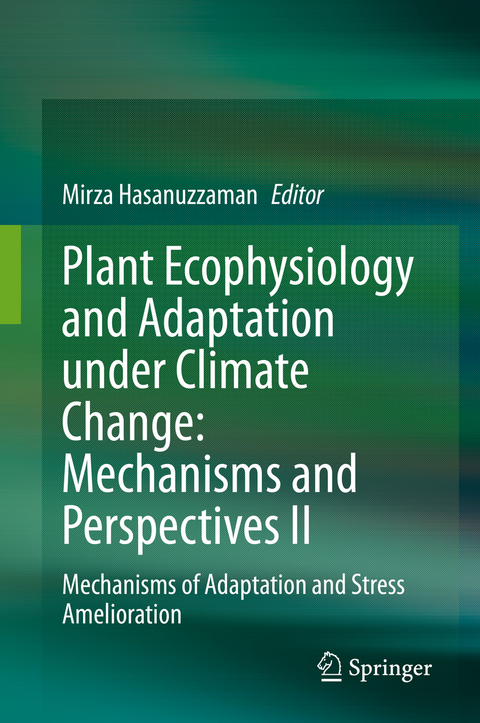
Plant Ecophysiology and Adaptation under Climate Change: Mechanisms and Perspectives II
Springer Verlag, Singapore
978-981-15-2171-3 (ISBN)
Volume 2 provides up-to-date information on the impactof climate change on plants, the general consequences and plant responses to various environmental stresses.
Mirza Hasanuzzaman is Professor of Agronomy at Sher-e-Bangla Agricultural University in Dhaka, Bangladesh. He received his PhD in Plant Stress Physiology and Antioxidant Metabolism from the United Graduate School of Agricultural Sciences, Ehime University, Japan, as a recipient of a scholarship from the Japanese Government (MONBUKAGAKUSHO). Later, he completed his postdoctoral research at the Center of Molecular Biosciences, University of the Ryukyus, Okinawa, Japan, as a recipient of the Japan Society for the Promotion of Science (JSPS) postdoctoral fellowship. Subsequently, he received the Australian Government’s Endeavour Research Fellowship for postdoctoral research as an Adjunct Senior Researcher at the Tasmanian Institute of Agriculture, University of Tasmania, Australia. Mirza Hasanuzzaman has supervised 20 MS students. His current work is focused on the physiological and molecular mechanisms of environmental stress tolerance. Prof. Hasanuzzaman has published over 120 research publications in peer-reviewed journals. He has edited 12 books and written 45 book chapters on important aspects of plant physiology, plant stress responses, and environmental problems in relation to agricultural plants. According to Scopus®, Prof. Hasanuzzaman’s publications have received roughly 4800 citations with an h index of 37 (As of April 2020). He is an editor and reviewer for more than 50 peer-reviewed international journals and was a recipient of the “Publons Peer Review Award 2017, 2018 and 2019.” He has been honored by different authorities for his outstanding performance in different fields like research and education and has received the World Academy of Sciences Young Scientist Award (2014). He has attended and presented 25 papers at international conferences in many different countries (the USA, the UK, Germany, Australia, Japan, Austria, Sweden, Russia, Indonesia, etc.). Prof. Hasanuzzaman is an active member of 40 professional societies and is currently the Acting Research and Publication Secretary of the Bangladesh JSPS Alumni Association. He is also a fellow of The Linnean Society of London.
1. Salinity stress management in field crops: An Overview of the Agronomic approaches.- 2. Improving cotton crop tolerance to drought stress through molecular approaches.- 3. Mechanisms of Plant Adaptation and Tolerance to Heat Stress.- 4. Molecular Mechanism of Plant Adaptation and Tolerance to Cold Stress.- 5. Mechanism of waterlogging stress tolerance in pigeonpea plants: Biochemical and anatomical adaptation under waterlogging.- 6. Mechanisms of Plant Adaptation and Tolerance to Metal/ Metalloid Toxicity.- 7.Arsenic Tolerance Mecahnisms in Plants and Potential Role of Arsenic Hyper- Accumulating Plants for Phytoremediation of Arsenic Contaminated Soil.- 8. Adaptive Strategies of Plants under Adverse Environment: Mitigating Effects of Antioxidant System.- 9. Biochemical and Molecular Mechanisms of Abiotic Stress Tolerance.- 10. Use of Biostimulants in Conferring Tolerance to Environmental Stress.- 11. Use of Phytohormones in Conferring Tolerance to Environmental Stress.- 12. Proline and Abiotic Stresses: Responses and Adaptation.- 13. Physiological Role of Gamma Aminobutyric Acid (GABA) in Salt Stress Tolerance.- 14. Sulfur Mediated Physiological and Biochemical Alterations to Improve Abiotic Stress Tolerance in Food Crops.- 15. Magnetic fields, temperature and exogenous selenium effect on reactive oxygen species metabolism of plants under flooding and metal toxicity.- 16. Grafting plants to improve abiotic stress tolerance.- 17. Role of Molecular Tools and Biotechnology in Climate Resilient Agriculture.- 18. Transcriptomics in deciphering stress tolerance in plants.- 19. Regulatory role of transcription factors in abiotic stress responses in plants.- 20. Molecular Marker Tools for Breeding Program in Crops/Plants.- 21. Plant-microbe interactions in developing environmental stress resistance in plants.- 22.Role of Plant Endophytes in Conferring Abiotic Stress Tolerance.- 23. Dark septate endophytic fungi (DSE) response to global change and soil contamination.- 24. Can mycorrhizal symbiosis mitigate the adverse effects of climate change on crop production?.- 25. Plant-microbe interactions in wastewater-irrigated soils.- 26.Phytoremediation of Heavy Metals: An Overview and New Insight on Green Approaches.- 27. Phytoremediation of metal contaminated sites.- 28. Current trends of phytoremediation in wetlands: Mechanisms and applications.- 29. Mechanisms of arsenic hyperaccumulation by plants.- 30. Biochar- a sustainable product for remediation of contaminated soils.- 31. Phytoremediation potential of Oil seed crops for Lead and Nickel contaminated soil.- 32.Adaptation of halophytes to the gradient conditions on the northern seas coast.
| Erscheinungsdatum | 08.06.2020 |
|---|---|
| Zusatzinfo | 41 Illustrations, color; 18 Illustrations, black and white; XXII, 861 p. 59 illus., 41 illus. in color. |
| Verlagsort | Singapore |
| Sprache | englisch |
| Maße | 155 x 235 mm |
| Themenwelt | Naturwissenschaften ► Biologie ► Botanik |
| Naturwissenschaften ► Biologie ► Ökologie / Naturschutz | |
| Naturwissenschaften ► Geowissenschaften ► Meteorologie / Klimatologie | |
| Weitere Fachgebiete ► Land- / Forstwirtschaft / Fischerei | |
| ISBN-10 | 981-15-2171-9 / 9811521719 |
| ISBN-13 | 978-981-15-2171-3 / 9789811521713 |
| Zustand | Neuware |
| Haben Sie eine Frage zum Produkt? |
aus dem Bereich


